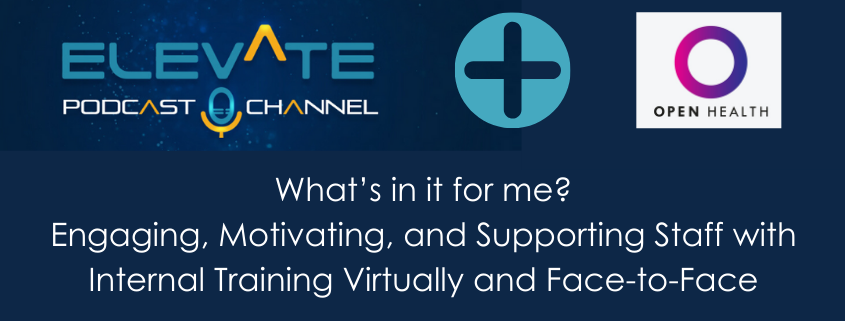In this second episode of the MAPS podcast series Elevate with medical communications and educational design experts from Open Health, we explore the development and delivery of internal training for Medical Affairs professionals: How do we ensure people do the training and can we also design for engagement and motivation? Does this look different in the digital environment?

MODERATOR: Jessica Ingram

SPEAKER: Dirk Saerens

SPEAKER: Briony Frost

SPEAKER: Ben Halford
Following is an automated transcription provided by otter.ai. Please excuse inaccuracies.
Garth Sundem
Welcome to this episode of the Medical Affairs professional society Podcast Series elevate, gathering the voices of Medical Affairs thought leaders and stakeholders to explore current trends, define best practices, and empower the Medical Affairs function. I’m your host Garth Sundem, communications director of maps, and today we’ll be speaking with Jessica Ingram, Managing Director of learning and development at Open Health and two of her team Briony frost Learning Design and Development Specialist, and Ben Halford, Account Manager. Open Health is a global full service medical communications agency offering Medical Affairs consultancy and content publications, medical education and internal training. Joining Jess Briony and Ben is Dirk Saerens, a Scientific Knowledge Manager from Janssen offering insights into how to engage, motivate and support staff with internal training. Jess, Ben, Briony, Dirk, welcome! And, Jess, I’ll hand it over to you.
Jess Ingram
Thanks very much, Garth. So last time we were here, we talked about the crucial role internal training plays in a much larger process of improving patient outcomes. And then we focused on how we can design and deliver and learning that positions the patient as the ultimate priority, and maximize the effectiveness of internal training in contributing to that overall goal. We’re back again today because there are a number of vital factors involved. A highly topical one given that we’re all living and working during a pandemic with recurring global lockdowns pushing us more and more into the virtual room of home working congresses, conferences, and of course training is engagement. After all, training is only as good as the engagement of learners with it. So the question we want to kick off with today is how do we ensure people undertake internal training programs that are provided? How can we best design them to ensure engagement and motivation? So Dirk, can I ask you to come in there?
Dirk Saerens
Yep. So what we have seen over the years of conducting trainings in different formats, is that when new colleagues in fact come on board, there is always a lot of eagerness, from their part to jump right into the content matter. However, the appropriate structure of this learning bot, or what we call attorney is crucial in the actual learning outcomes you want to in fact, achieve. So even more, since most of the colleagues we train daily at the onset are facing HCPs in their role, they also need to understand the main proponent in their story. And that’s in fact, the patient. So looking at the current setup of training, aligning the journey of a colleague learning the topics, in fact, and the actual journey of a patient would go to the diagnosis of the disease to treatment selection that really does aid in engaging the learner into the journey. And because one important point is really to stress that when the HCP selects the treatment for the patient, this is most often also personalized towards this patient in some form or the other. So this is due to the fact that not every patient, in fact, is alike. And HCPs needs to really consider multiple factors in the sometimes mutual treatment decision. Now similarly, you can look at the learning experience. And that has to become more and more personalized as well. And this can be based on testing before during the training and evening effect throughout the trainings. And moreover, in addition to just building this knowledge on the content for the learner, increasing also the confidence in that knowledge, in fact, does add an enormous value for the learner as well.
Ben Halford
Yeah, and just to come in here to add what Dirk has said, there’s certainly parallels between the patient journey and the process that learners go through. It’s always important for us to bear in mind that in the same way a patient might be engaged and motivated by the direct impact that conditions having on them. A learner will likewise be motivated by highly individual goals. So most people who go into health care, as we know are kind of often driven in part by wanting to help improve the experience and outcomes for patients. But every individual will have other more personal motivations. And there’s trainers we can’t know and respond to every single one of these, of course, but what we can do is make sure that we set up a training so that our learners always know what’s in it for them.
Briony Frost
You’re absolutely right, Ben, and I think one of the most powerful resources we have when designing training programs is the learners themselves. I touched on this in our last podcast with the importance of undertaking A learning needs analysis. And that actually, it’s more than just identifying the gaps in the training that the than the intense the needs that should be addressed. It’s also about recognizing learners as a key stakeholder in their own learning, getting them involved in the design of their own training, we need our learners to be able to identify for themselves what they need to know why they need to know it, and how it will help them achieve their goals. And a needs analysis gets us started with that process long before the actual training begins. It gives learners a sense of investment at an agency in their training. So they start off already motivated to learn. And then it’s up to us to keep that ball rolling through the rest of the design and delivery process.
Dirk Saerens
Yes, indeed. And when you develop the training, you always have the endpoints in sight. And for each of the steps in between the starting point, towards the end point, you really need to set up what is exactly the learning outcome or even the learning objective, you want the learner to reach and to be able to take the next step in that learning journey and a search. With every learning or learner being different. This learning journey really needs to take these differences into account. So for example, someone coming in brand new into the role, would most likely to start at the first level to get to a basic level of knowledge. And also to have the required confidence level in that knowledge. However, there might be others that joined the team, and would not need to start at the basic entry level, so to say, but could immediately start at a level higher or even a couple of level higher. So therefore, the need to check this knowledge at the baseline level, before departing really on a learning journey that is personalized, is really critical for the success and also to have the highest possible engagement of the learner.
Jess Ingram
I completely agree, Dirk. And I think we all know that there’s a real move towards bite size training content, and it makes complete sense. But I think some of the danger there is that it can then feel very difficult to to work out what the journey is and and know that the individual pieces of content really connect and help move you on that journey. So I think, as we’re designing programs, it’s so important that we get the signposting right, and really help show people that there isn’t one specific path they have to follow. But here’s some suggestions and different options that might work for them. So that they can really see how the individual pieces of content will will help them move through that journey. And I think we also need to make sure that everything they’re doing is is really relevant to their real life role. And making sure it comes back to the conversations that they’ll be having with with healthcare professionals, if they’re an MSL, or whatever else is that we’re really defining his learning outcomes. So having talked a little bit about design, I guess my question is, is that where we really have to focus all of our attention? Or are there other tools and techniques that we can use in this area?
Briony Frost
Oh, no, absolutely. delivery is really important too. And we need to make sure we’re thinking about engagement right from the design phase, because a little bit like, learners tend to jump in and get distracted by the content, it’s really easy for us as training providers to get excited about all the innovative tools and techniques available for delivery and then just plunge in. And I want to use this because it’s because it’s awesome. And unfortunately, that that sort of approach tends not to be very coherent or effective. But if you can combine designing for engagement with relevant well thought through selected and positioned engaging delivery tools, then you get a heck of a lot more bang for your buck than you would have if you just use one or the other. At circumvent, you want to chip in with some of your favorite examples here.
Dirk Saerens
Ah, sure, because yeah, I could give a lot of examples, but I will give only two. And in fact, two of my favorite ones in this, I would call it a new normal virtual environment. And first of all, there was always a need to gather people around the learning experience in a in a larger group. It was face to face now it’s at this moment in time, more virtual. And one application that really started to work for face to face events is the guidebook application. Now this allows us as organizers of those educational or training events to really gather all participants or attendees around one platform. And it dition also enables us to engage with that content, and also each other to prepare and come in advance to that face to face meeting. But also after the meeting itself. You can go back and see what happens and maybe even chipping to one of those content pieces. Now it gives also the learner, a landing platform or really a backbone from where the actual learning would start and would also maybe continue on to different other platforms or even sessions either face to face or virtual. Another example that has really been taken up well by learners in a virtual environment is the combination of a couple of platforms. And at the onsen, we have been piloting zoom, and the Moodle platforms, combines and we all know zoom as the way we interact now virtually with each other. However, the main question did arise on how really can we mimic in the best possible engaging way, those face to face breakout sessions around learning on the knowledge but also engaging with other learners around that content. Now, one of the platforms we have so identify to clearly mimic that with small learning groups in a virtual setting is by using the zoom breakout functionality together with the mural platform. Now, some of you might say mule is a little bit of a whiteboard. However, it is much more than a simple whiteboard application because it has endless possibilities to develop specific sessions or exercises around the content, and to get into a very engaging discussion with a very small learning group.
Ben Halford
And just to expand on what the spoken about there, there’s a range of techniques that we like to use to increase engagement in our training activities, whether that be virtually or face to face. I think Becky spoke last time in the previous podcast about embedding patient or HCP videos. And this obviously makes the patient experience come to life and reinforces that goal of improving patient outcomes. Also, a multimodal approach can really help learn to stay engaged with the content because it appeals to so many different learning styles and helps to break things up. So it’s constantly re engaging the attention and providing that much needed reinforcement. People will always remember information better if they’re going to encounter it in multiple mediums. In addition, additionally to that, getting learners to be actively engaged in things can really, really help. For example, in live sessions, we do temperature checks, because you can adapt content, or go back over information if people need reinforcement or further explanation. And it’s really that formative feedback that keeps learners engaged because they have to think about where they are in terms of their understanding. Similarly, polling activities are a great option for keeping people focused as they provide instant feedback for peers and trainers as well. It’s also important to mention here that these things can be successfully adapted for the virtual realm as Doug spoke about to, for example, digital polls with visible results and pop up feedback. And those temperature checks that signpost learners on to the next piece of content, or even go back to previous sections if they’re unsure or on anything. And finally, conversely mentioned guy, but can mural there. So just to bring up another one of our favorites in competition and gamification, which really do add a new dimension to learner engagement. It’s obviously kind of important to keep it fun and healthy level. But framing learning tasks with a competitive backdrop can be really, really positive for knowledge retention, as well as building that that confidence that we spoke about. For example, like at a live event, you could split participants into teams and run a quiz on the previous plenary session using an interactive app. Or perhaps you could even design a topic specific board game, which gives tables the opportunity to interact and learn together as they play, or even thinking from a more virtual standpoint, you could run a monthly competition based on your digital micro learning platform with users teamed up by various regions. So there’s really a huge amount of possibilities, kind of on offer, and they all work because people really do like to win.
Briony Frost
Yes, they do. I think these are brilliant examples of how to do engagement really well in the delivery phase of training. And as I mentioned before, what makes them work best is when they’re joined up throughout the training. If you can make sure you embed logical connections between each of your engagement activities and ideally have activity types that repeat often enough to be familiar, then you really do boost learner confidence in engaging that way. What you don’t want to do is throw in loads and loads and loads of different engagement activities. Types because the unfamiliarity of the task, in addition to potentially new content and refined skills can be off putting by itself. You don’t want people to get sick of an activity, but you do want to be comfortable enough to use it. So looking for opportunities for people to essentially practice. And then increasingly master types of activities as well as content and skills is really important when you’re thinking about how to have the most impact in your engagement activity space. Thanks, guys, I
Jess Ingram
think that’s really great as kind of exploring some of the theory behind it. And then also some really practical examples of, and tips of things we can do. And in the interest of time, I think it would be great if we can move on and say, what other considerations are there for helping us keep our teams engaged and motivated throughout this process?
Ben Halford
Yeah, thanks, Jess, I was going to touch on digital platforms actually a little bit, it’s very important to use one which is easy to use and also motivates engagement. It’s really easy to have a platform, which is just to kind of repository for loads of content. But if it doesn’t present and deliver that content, intuitively to learners, it’s never really going to have a meaningful impact to them. The format needs to be varied to cater to different learning styles and knowledge tests need to be structured so that they’re meeting genuine learning objectives, and enhancing the confidence not just testing people for the sake of it. We’ve mentioned it before. But instantly, feedback from test is really important too, as it gives learners the opportunity to rectify any mistakes at the time they’re doing the training, which will improve their outcomes as well. We also spoke about engagement a little bit and the platform that helps to keep learners on the ball with push notifications, particularly to their mobile devices, is very simple, but it’s also very effective. We all lead busy lives and sometimes training, you will understand that they take a backseat. But after a hectic Monday, a push notification for the learning platform the next morning can act as that useful reminder to ensure that your training stays front of mind and does remain a priority for the week.
Dirk Saerens
Yes, indeed. And from my experience, certainly throughout 2020. Now it’s a it has become really clear that instead of really putting as a subject matter expert, the content knowledge and the confidence at the heart of the learning experience, we might need to move really from, I would say that at the heart into a more personalized education and put the learner In fact, at the center of the whole experience. And by the multiple techniques as nicely discussed today, and also all the platforms, you can really start making a difference and also be able to more appropriately engage your audience for the education and it’s will reach I would say a lot of learning objectives.
Briony Frost
Yeah, definitely. I think one other crucial thing to mention here is that when you’re providing training, you need to think as well about supporting staff mental health, there’s a broader landscape here around workplace well being. But in terms of training, there is some specific things that can be done. The onus here is to a degree on the leadership team to make sure that staff have time to train, and that they’re able to create space in their schedules to do it in a realistic timeframe. And without having to add on potentially unpaid hours. It’s about communicating with learners and giving them that chance to get involved in the needs analysis, yes, but it’s also about messaging around training, what needs to be done by whom, by when, and being invested in individual team members goals through things like personal development reviews, and meetings and one to ones. And thinking about how training fits in with that, being clear about how each piece of training contributes to the overall strategic picture of the company and how each person can participate in making that a reality. It’s also about making training accessible to staff. In the UK employers are bound by the 2010 Equality Act to make sure that all staff can engage equally with training materials. And that means things like making sure that materials are available in alternative formats. For example, things like if you’re going to have a video, make sure you’ve got captions and transcripts, and that they’re usable for people who are relying on assistive technologies. And also things like recognizing when people might need what we call reasonable adjustments, for instance, more time to undertake a task or additional technologies. Even something as simple as providing a decent headset to ensure that any audio is clear. It’s all these little things that facilitate people’s access to the training and making sure that they’ve actually got the opportunity to engage, because we don’t want these barriers to crop up. And to prevent people from engaging with the training when when they want to. It’s the quickest thing it’ll switch them off. I think the other thing is that it’s really important not to underestimate how vital it is to provide access to help and support during training. Who should your learners go to? If they encounter a technical problem? Who do they ask if they have any questions about what they should be doing and how, where do they get more information and setting up within the within your company things like mentorship schemes, and buddy systems, and clear points of contact go a long way to facilitate what’s known as positive help seeking behavior. Knowing who and how to ask for help means you’re much less likely to have learners get frustrated and disengage. Because they’re too tired or too confused or too overwhelmed to resolve a training challenge. You’ll never be able to completely design these things out because learners are individual in all circumstances are individual. And even if you could computers have a bit of a mind of their own and tend to decide to just turn themselves off on the day. So you need to be clear about what learners do when they encounter a problem. So they can quickly see how to solve it. And then they’re much more likely to see the training through and then stay engaged with it after an incident.
Jess Ingram
Great, thank you, everyone. So I think we’ve covered a lot there. And and my real takeaway message from that I think is is when we take all of those things together that really allows us to create positive learning environments where learning can be self directed, which really improves the learner experience, and therefore their engagement and motivation. And certainly, as training providers, the onus is definitely on us to, to seek feedback and to really build that feedback into the training program so that we can continue to improve them as we as we move forward. And actually, that really nicely links on to our next podcast, which will be the final one in this miniseries, where we will be exploring the impact of how we measure internal training and how we then use that information to to improve design moving forward. So that’s it for today. Back to you Garth.
Garth Sundem
My feedback is that that was fascinating to listen to. And so thanks, Dirk, Jess, Ben and Briony for joining us today. To learn more about how your organization can partner with Open Health to drive positive change in health care, communications and market access. Visit Open Health group.com maps members continue the conversation at our community portal and don’t forget to subscribe. And we hope you’ve enjoyed this episode of the Medical Affairs professional society podcast series, Elevate.






